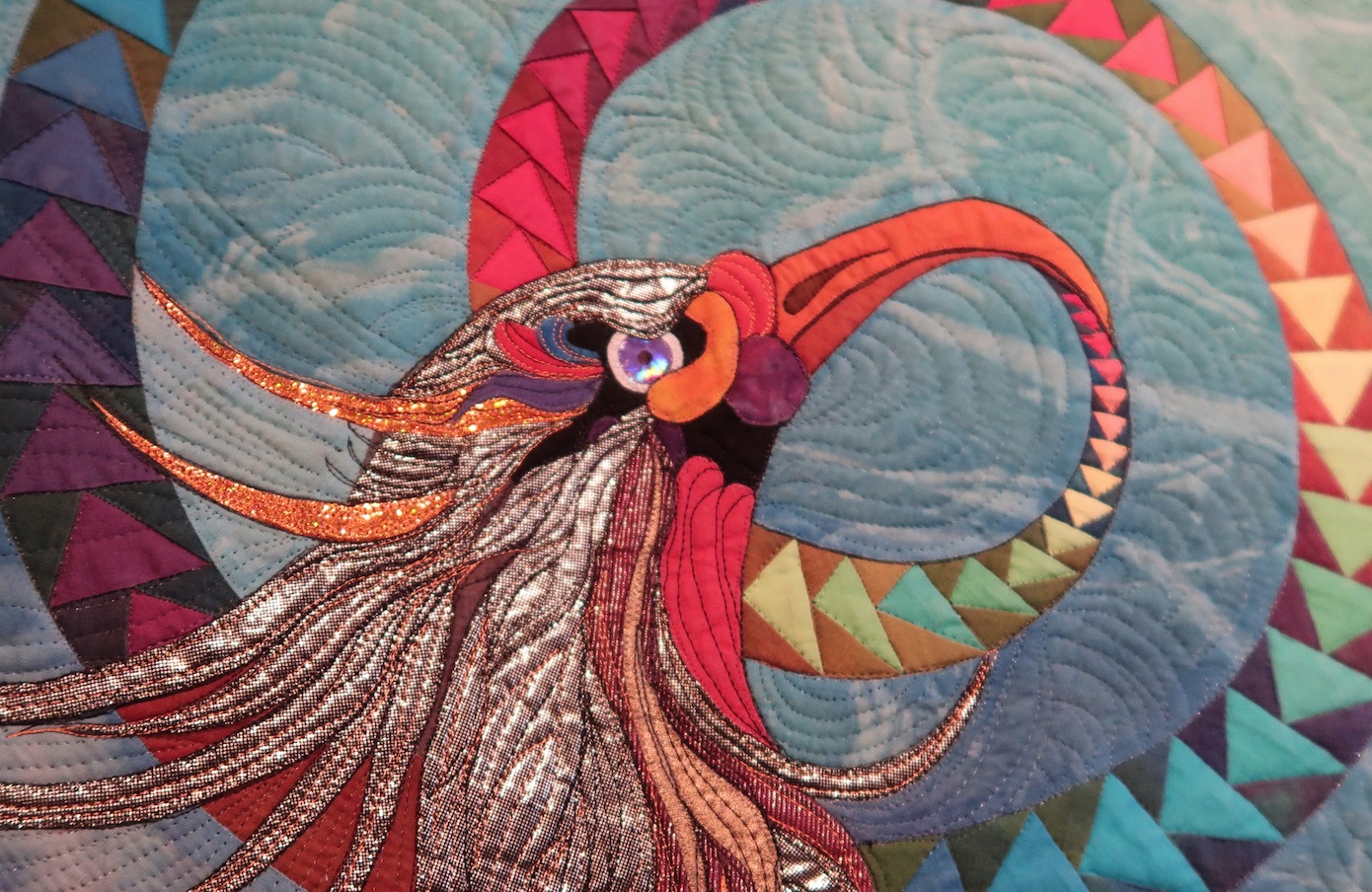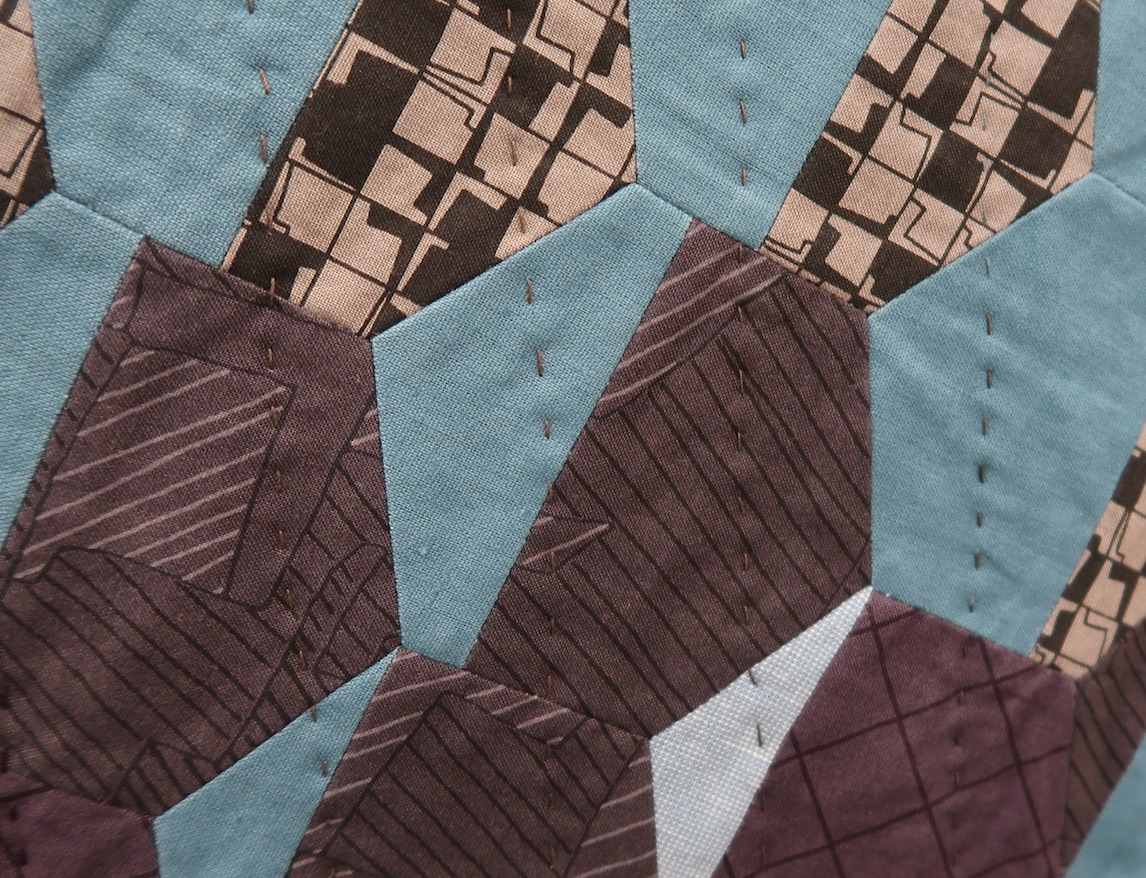Alex is back sharing her thoughts on Pinning for Success. She also shares what happens when...
Alex is back sharing her thoughts on Pinning for Success. She also shares what happens when...
Russian Mosque is one of Karlee's very favorite quilts. She made it when she was just developing her Graffiti Quilting technique. She named it Russian Mosque because the column of designs going up the center of the quilt reminded her of those historical, onion-topped buildings in Russia. This quilt is about 15″ x 22″ and packs quite a punch as far as thread count is concerned.
Watch Karlee in Show 2607.

Original Photo: Mary Kay Davis
In this lesson let's look at how using line to create maximum effect does not have to be complicated. Deborah Boschert (Show 2108: Surface Design Simplified & Vintage Quilt Bed Turning) shares how she uses the elements of line to 'captivate the viewer' by examining two of her quilts. Through the use of subtle, but effective lines, Deborah shows how she holds the viewer's attention as they are guided along the journey around the quilt.
When designing a quilt, all the elements are carefully chosen to work together to create the over all visual impact. Line is one of the elements that can be a part of the design. A line can define a shape, suggest movement, add texture or fill a space. It can be thick or thin, straight or curvy, controlled or random. It can be created with fabric, stitching, or surface design.
It’s helpful to embrace these different ways to describe and understand line. Then when you are designing a quilt, you can think clearly about the different ways line can be used to maximum effect.


Green Bowl Gathering Small Multitudes
In quilting, a line can be created in so many ways! Let’s look at some examples. In Small Multitudes and Green Bowl Gathering, we can deconstruct the art quilts and pick out different ways I’ve used line.
In both, I’ve outlined the bowls using strips of fabric fused over the bowl shapes. I chose to make the lines relatively chunky and irregular. These lines remind me of thick magic marker sketches. Imagine how different it would look if I’d placed the outline precisely along the edge of the bowl shapes with no breaks or overlapping.

Detail Small Multitudes by Deborah Boschert.
Both art quilts also have arched lines at the top. In Small Multitudes, the line is hand-stitched in yellow. In fact, each stitch is a tiny line and they work together to visually create the arched line. Additional arches are machine stitched in black thread. Those are much thinner, more subtle lines. In Green Bowl Gathering, I machine stitched similar lines in red. Making several lines of stitching over lapping each other and in slightly different shapes creates the overall effect of an arched line, but the multiple lines give it variety, movement and interest.

Maybe the most dramatic line in Green Bowl Gathering is the strong, horizontal strip that goes all the way from the left to the right. Everything else is built up around that line. (This horizontal line is made up of the shorter vertical lines of the striped fabric. Think about how different it would look if I’d used that same fabric with the stripes running horizontally.

Small Multitudes by Deborah Boschert.
There are several other small details incorporating lines in these two quilts. The tiny seed stitches that appear to fill the bowl are lines. The free motion quilted leafy shapes in the background are also lines.

The green circles in Green Bowl Gathering are printed with paint — some thick and blobbly, others thin and faint. When you consider the possibilities of each individual line, you can really take control of the design of a quilt.
As you’re designing your own original art quilt, zero in on the idea of how you can use lines to maximum effect. Will the lines be made from fabric? Or stitched with thread? Or created with paint, ink or dye? Think about how the design would change if a line were thinner or thicker. Are you most comfortable making controlled straight lines? What would happen if you tried something loose and gestural?
There’s no right or wrong way to think about all these details. But, giving them some close consideration may open up new possibilities in the creative process.
To learn more about Deborah Boschert, visit her website, follow her blog, or sign up for her newsletter.

Looking for ways to use line when it comes to a traditional design? Let's look at Janet Stone's Red Letter Daze. Janet (Show 1401: From ABC to BOM - Tips and Techniques Just for "Ewe") loves to take the viewer on a journey around, across and into her quilts. A huge fan of over the top details, see if you can spot how many ways Janet has included line in her 2012 NQA Masterpiece Award Winner.
Red Letter Daze a quilt by Janet Stone. Photo by Gregory Case Photograpy for TheQuiltShow.
Here are a few examples of Janet's masterful use of line:
Notice (left image) how the curved red lines flow along the edge of the outside border, while Flying Geese (and an occasional small block) take the eye journey around the central creamy field.
Notice (right image ) how the letters of the alphabet and the repeated curved lines flow around each of various block designs. The gentle curves of the letters and undulating lines help to soften the more angular Flying Geese and blocks in the center field.


Detail of Red Letter Daze. Photos by Gregory Case Photography for TheQuiltShow.
See the entire quilt in our zoom format here.

Adaptation of hand drawing exercise from Art is Every Day by Eileen S. Prince
Place your non-dominant hand and bare forearm in a pleasing manner on a piece of white paper. Splay your fingers slightly, but keep your thumb as vertical as possilble. Using a pencil, lightly trace around your arm and hand. Place or draw another object, such as a heart, near your hand tracing. Trace this item lightly as well.
Using a dark marker, begin drawing a straight line (from the left side of the page) parallel to the lower edge. When you come to your pencil line, curve the line up slightly. Curve back down to the pencil line on the other side, and continue across the page. Repeat with each new line being about 1/4" above the previous. Try to keep your lines as straight and horizontal as possible. Repeat the process for the heart.
On a piece of plain fabric trace your hand and the heart in the same manner as Option 1. Make a quilt sandwich and machine quilt with a thread of your choosing using the same method of curving slightly when you reach a traced line.
Click here for more topics related to The Art of Quilt Design program.
We continue our feature on quilts from the Studio Art Quilt Associates (SAQA) exhibit, Layered & Stitched: Fifty Years of Innovation, as featured at the Texas Quilt Museum. The exhibit is described as:
Studio Art Quilt Associates presents Layered & Stitched: Fifty Years of Innovation at the Texas Quilt Museum in Galleries I and III. These studio art quilts, dating from 1968 to 2016, represent the extraordinary range of talented artists working in contemporary quilt art. Featuring a balance of abstract and representational styles, Layered & Stitched includes several foreign artists, with a wide geographic distribution of makers in general. The curatorial vision of this exhibition embraces diversity and excellence, including three-dimensional works. Juried by Nancy Bavor, Director of the San Jose Museum of Quilts & Textiles; Martha Sielman, Executive Director of SAQA; and Dr. Sandra Sider, Curator of the Texas Quilt Museum, who says, "Jurying this spectacular exhibition was one of the highlights of my career! It is an amazing show of historic significance."
The exhibit has also been collected in a companion book as well, titled Art Quilts Unfolding: 50 Years of Innovation by Nancy Bavor, Lisa Ellis, Martha Sielman, and edited by Sandra Sider. The book is described as:

Please enjoy the third quilt from the exhibition by Caryl Bryer Fallert-Gentry.
Title of Quilt: New Dawn
Quilter's Name: Caryl Bryer Fallert-Gentry




Photos by Mary Kay Davis
Betsy Vinegrad's quilt, Turn Ahead, is a very small quilt with lots of little pieces that she began in a Nancy Crow class. Listen to Betsy as she describes how the quilt came to be and discover what color she found out she actually liked. This design method might be something you'd like to try.
Turn Ahead by Betsy Vinegrad, of Short Hills, NJ and the North Jersey Modern Quilt Guild, won Second Place, Small Quilts at QuiltCon 2020.





Photos by Mary Kay Davis
Karlee's quilt, Explosion, was created using a single piece from her fabric line. The idea was that you could have a beautiful quilt, even if you are not the best "piecer". In essence, it is a wholecloth quilt.
Learn more about Karlee's fabric line in Show 2607.

Original Photo: Mary Kay Davis
Carolyn Friedlander took the hexagon shape and split it in half to create her Arlo Quilt. She then played with the orientation of the blocks while changing the color story.
Arlo Quilt by Carolyn Friedlander, of Lake Wales, FL, won Second Place, Modern Traditionalism at QuiltCon 2020.





Photos by Mary Kay Davis
 During this time of staying in place, Ricky is reading chapters from the soon-to-be-released book titled Lizzy Albright and the Attic Window, written by Ricky Tims and Kat Bower. The VidPods (for listening while you create), are found on a Playlist on YouTube. So you can start, and they will automatically play one after the other. Click here to go to the playlist.
During this time of staying in place, Ricky is reading chapters from the soon-to-be-released book titled Lizzy Albright and the Attic Window, written by Ricky Tims and Kat Bower. The VidPods (for listening while you create), are found on a Playlist on YouTube. So you can start, and they will automatically play one after the other. Click here to go to the playlist.
This exciting adventure/fantasy story is for all generation who are reading chapter books. Kids as young as eight years old can fall in love with Lizzy, as can anyone who loves a fun adventure. The nostalgic opening of the book is set in 1964, when Lizzy Albright is ten years old. The story is a multi-layered story, but it all comes together in one very climatic ending.
The book, which features a depression era quilt, will spawn a quilt pattern book, a line of depression era fabrics designed by Ricky Tims for Benartex, and so much more. Listen to the book now, pre-order your autographed copies, and get ready for the excitement. Described as Harry Potter meets the Wizard of Oz, meets Alice in Wonderland, it’s sure to be a hit.
The Lizzy Albright Quilt and line of fabric will be revealed on April 11, LIVE on YouTube and Facebook, at 3PM Eastern, noon Pacific. You’ll be even more excited about the reveal if you have made it through at least Chapter Seven of the VidPods.